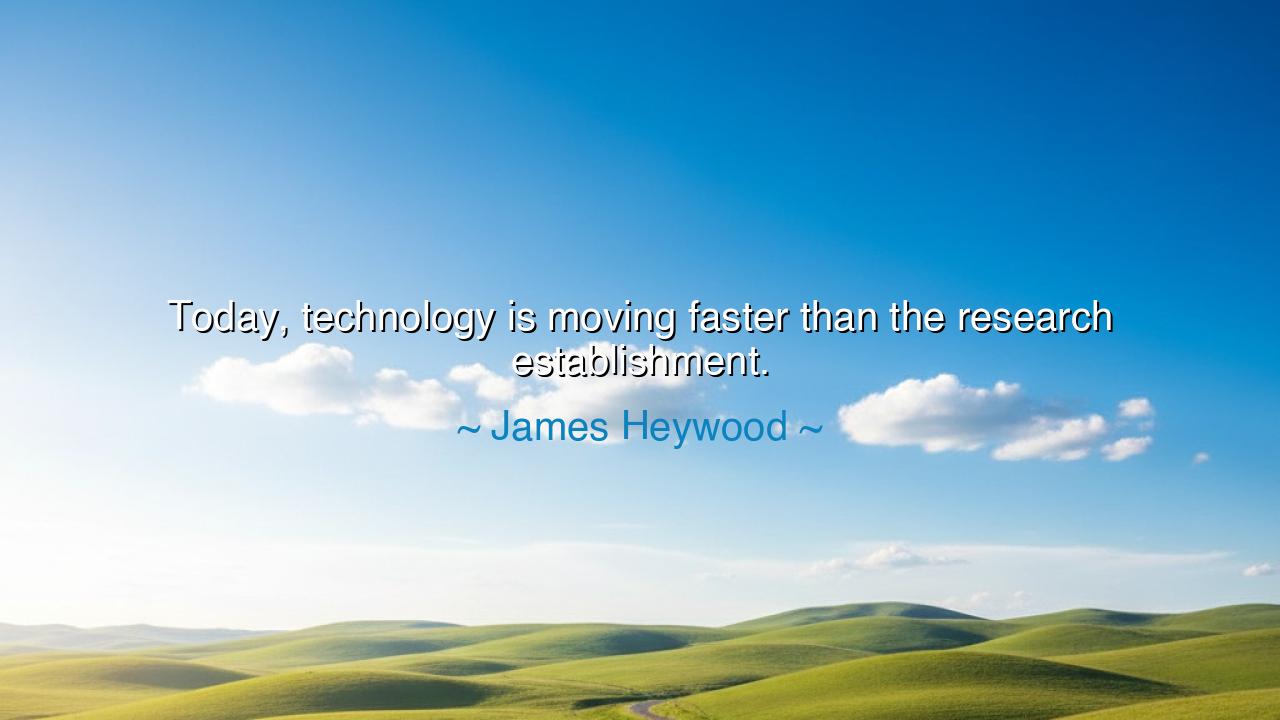
Today, technology is moving faster than the research






Hear the words of James Heywood, spoken with urgency in the face of change: “Today, technology is moving faster than the research establishment.” In this brief yet thunderous statement, he lays bare a truth of our age—that the engines of invention run with such swiftness that the guardians of knowledge, those who test, measure, and verify, can scarcely keep pace. Technology surges ahead like a river in flood, while research, careful and methodical, trudges behind. This is not condemnation, but warning: the balance between discovery and wisdom must not be lost.
The origin of this wisdom is found in the tension between innovation and oversight. For all ages have known inventors who leapt ahead of their time, but in our century, the leap has become a sprint. Technology advances daily—in medicine, in communication, in artificial intelligence—yet the research establishment, bound by the disciplines of caution and proof, cannot move with equal haste. Where once invention awaited the verdict of knowledge, now invention storms ahead, demanding that understanding catch up.
The ancients themselves glimpsed this danger in another form. Recall the myth of Prometheus, who stole fire from the gods and gave it to man. Fire was a tool of boundless potential—warming, forging, and illuminating. Yet it also burned, destroyed, and consumed. Humanity received the gift before it had the wisdom to wield it. So it is with technology today: new fires are granted into our hands before the scholars, the teachers, the healers, and the lawmakers have fully reckoned with their power.
Consider the story of nuclear power. In the mid-twentieth century, science unlocked the atom’s secrets, releasing a force of unimaginable potency. Yet before research could fully explore its dangers and safeguards, the world had already unleashed its destructive side upon Hiroshima and Nagasaki. Here, Heywood’s words find their mirror: technology had raced ahead, and research had not yet steadied its hand. The result was both progress and peril, light for the world and shadow for mankind.
And look now to our own time, where artificial intelligence, genetic engineering, and digital networks reshape society faster than laws, ethics, or even human comprehension can follow. New machines decide in fractions of a second; new codes alter life itself; new networks bind billions of voices into one vast chorus. Yet the research establishment, like a wise elder, moves slowly, testing, reviewing, demanding evidence. The gap between the swiftness of invention and the slowness of wisdom widens, and in that gap lies both promise and danger.
What Heywood teaches us is this: speed is not always strength. The chariot that races too quickly may overturn, while the one that moves with care endures. Yet neither can be abandoned: the inventors who push the boundaries must be honored, but the researchers who anchor their discoveries in truth must be heeded. The challenge of our age is not to halt technology, nor to burden it with fear, but to build a bridge between innovation and wisdom, so that progress may be guided and not run wild.
The lesson for future generations is plain: embrace wonder, but demand understanding. Celebrate the brilliance of invention, but temper it with patience, humility, and oversight. Do not chase every shining new tool without asking what it serves and what it endangers. Support not only the makers of new things, but the thinkers and testers who ensure those things do not betray us. For technology without wisdom is a blade without a hilt—sharp, powerful, but dangerous to all who wield it.
Therefore, let your actions be thus: learn not only to marvel at the speed of progress, but also to honor the slower rhythm of truth. Demand balance, seek wisdom, and remember that the greatest gift of mankind is not to invent without pause, but to guide invention toward the good of all. For Heywood’s words remind us that while technology may race ahead, it is only through patience, discipline, and wisdom that humanity will endure the future it creates.






AAdministratorAdministrator
Welcome, honored guests. Please leave a comment, we will respond soon